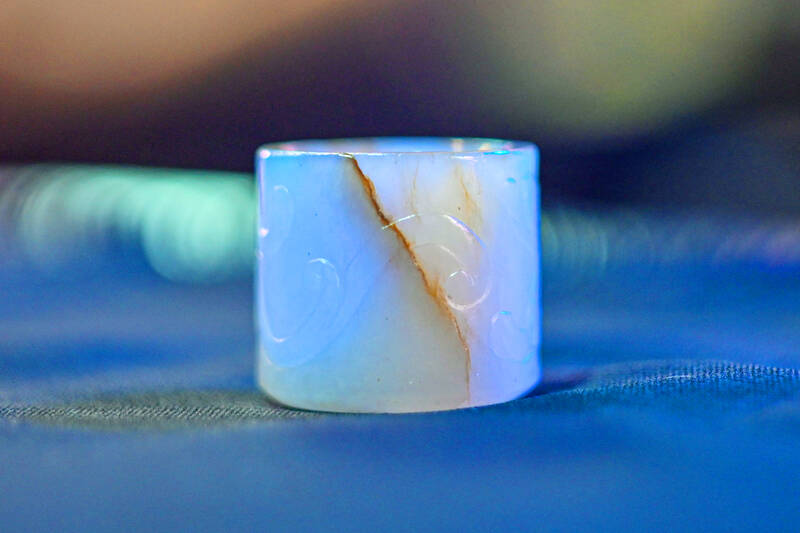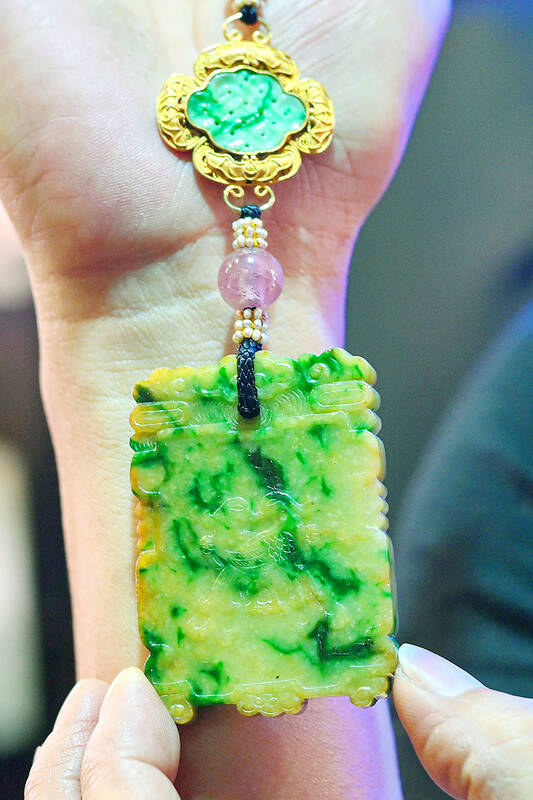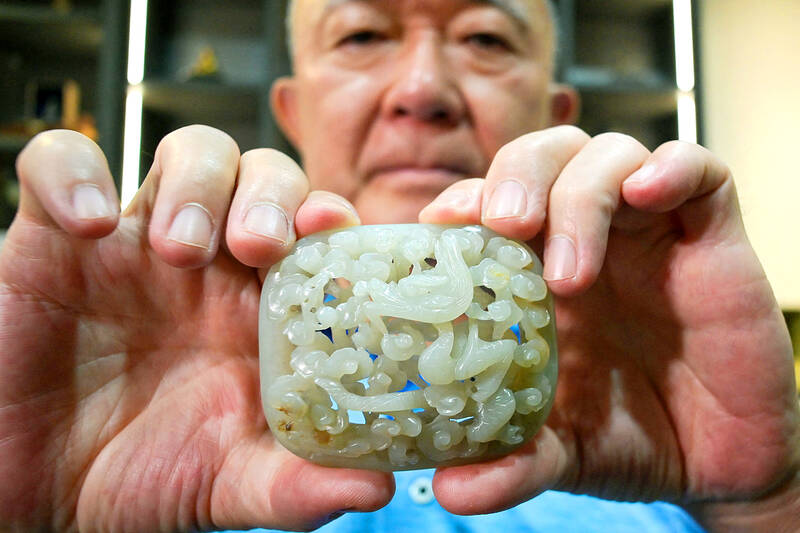Tracing a palm-sized jade pig resting on its haunches, an antique trader in Taiwan said the ears on the nearly 400-year-old piece are a marker of its authenticity.
“The folds in the pig’s ears show the handiwork, the ancient handicraft” of the Ming Dynasty (1368-1644), said the 60-year-old trader, who would only provide his last name as Lee. “It takes very careful carving. If it were duplicates, they wouldn’t make it that delicate and detailed.”
Lee’s shop in Taipei’s Daan district holds ancient treasures worth more than a condominium located in the same neighborhood. The value of his merchandise represents just a fraction of an industry that the island’s jade association says brought in nearly US$16 million annually in recorded pre-pandemic antique jade sales.

Photo: AFP
But dealers warn the sector is flagging post-COVID. With the global economy in tatters, buyers are more cautious about taking a chance on expensive items, especially with the market awash with counterfeits. Taipei’s worsening ties with Beijing have also meant restrictions are still in place for visitors from China, effectively cutting out the industry’s biggest buyers. Relations have plummeted since Taiwanese twice elected President Tsai Ing-wen (蔡英文), who refuses to accept Beijing’s claim that the self-ruled island belongs to China, was elected in 2016.
“About seven to 12 years ago, it was very good times for people in Taiwan who are in the antiques or jade trade,” said Liu San-bian, who runs a store in Metropolitan Jewelry and Antiques Emporium. “It declined when cross-strait politics slowly affected travel between both sides,” he said, summing up the dilemma in four Chinese characters meaning: “Hard to buy, hard to sell.”
“Chinese people stopped coming in and rich people in Taiwan are not buying. There is no supply in the market... and collectors here are not willing to release their items for sale.”

Photo: AFP
‘INGRAINED IN OUR DNA’
Taiwan was the go-to place for hunters of Chinese relics long before it became a powerhouse for hi-tech semiconductors. Collectors said most were carried out of China during the Cultural Revolution, ending up on the island and nearby Hong Kong.
The Chinese government generally considers the trade of antiques from historical eras to be illegal if they were not passed down through inheritance or bought from authorized venues, such as cultural relic stores.

Photo: AFP
But there is a grey area in Taiwan, where collectors say they have obtained the items through legitimate means, especially if the items were personal belongings.
“To the Chinese, it is ingrained in our DNA,” said Chang Ju-ben, chairman of Taiwan’s Association of Jade Collectors.
“Collectors in Taiwan began collecting when they realized that these were valuable national treasures... Taiwan has a reputation in the Greater Chinese community, that you can come here to see, touch and buy good jades here.”
The antique jade market took off around 2011, when Beijing-friendly Ma Ying-jeou (馬英九) was president, bringing in “an endless stream of buyers from China and other countries,” Chang said. Now Taiwan’s market is about a quarter of its former annual value — roughly US$9.4 million to US$15.7 million in the boom years — and it is easy to be steered towards inauthentic “artefacts.”
“It relies on word of mouth,” Chang said. “You have to walk the right path and find the right person.”
Most reputable collectors are also “protective” about their stock, refusing to show their best items to a novice who won’t appreciate it or to a buyer simply looking to resell for profit.
‘BUILD A REPUTATION’
A two-hour flight to Hong Kong — a hub for Chinese antiques sold in both sprawling markets and upscale auction houses — tells a different story.
Pola Antebi, deputy chairman at Christie’s auction house in Hong Kong, said she is seeing a trend in which antique collectors are releasing long-cherished collections held for up to five decades.
“We’ve sold several substantial collections from Taiwan in Hong Kong in recent years, including the notable Chang Wei-hwa collection of early jades,” Antebi said.
That portfolio of jades from the Qin and Han dynasties fetched US$9.3 million in November, while three previous auctions of Chang Wei-hwa’s collection brought in US$24.7 million from 2019 to 2021. Taiwan’s jade “players” remain confident the trade “will survive no matter what,” said the trader Lee.
His unique shop, which houses aquariums of iridescent corals, gets visitors via word of mouth. One trip can turn into several before any transaction is made — if at all.
“It takes very long to build a reputation, but it is very easy to ruin it. If one item you sell turns out to be fake... that’s all it takes to ruin you,” he said.

Exceptions to the rule are sometimes revealing. For a brief few years, there was an emerging ideological split between the Democratic Progressive Party (DPP) and Chinese Nationalist Party (KMT) that appeared to be pushing the DPP in a direction that would be considered more liberal, and the KMT more conservative. In the previous column, “The KMT-DPP’s bureaucrat-led developmental state” (Dec. 11, page 12), we examined how Taiwan’s democratic system developed, and how both the two main parties largely accepted a similar consensus on how Taiwan should be run domestically and did not split along the left-right lines more familiar in

This month the government ordered a one-year block of Xiaohongshu (小紅書) or Rednote, a Chinese social media platform with more than 3 million users in Taiwan. The government pointed to widespread fraud activity on the platform, along with cybersecurity failures. Officials said that they had reached out to the company and asked it to change. However, they received no response. The pro-China parties, the Chinese Nationalist Party (KMT) and Taiwan People’s Party (TPP), immediately swung into action, denouncing the ban as an attack on free speech. This “free speech” claim was then echoed by the People’s Republic of China (PRC),

As I finally slid into the warm embrace of the hot, clifftop pool, it was a serene moment of reflection. The sound of the river reflected off the cave walls, the white of our camping lights reflected off the dark, shimmering surface of the water, and I reflected on how fortunate I was to be here. After all, the beautiful walk through narrow canyons that had brought us here had been inaccessible for five years — and will be again soon. The day had started at the Huisun Forest Area (惠蓀林場), at the end of Nantou County Route 80, north and east

Specialty sandwiches loaded with the contents of an entire charcuterie board, overflowing with sauces, creams and all manner of creative add-ons, is perhaps one of the biggest global food trends of this year. From London to New York, lines form down the block for mortadella, burrata, pistachio and more stuffed between slices of fresh sourdough, rye or focaccia. To try the trend in Taipei, Munchies Mafia is for sure the spot — could this be the best sandwich in town? Carlos from Spain and Sergio from Mexico opened this spot just seven months ago. The two met working in the